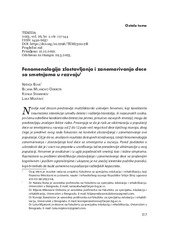Приказ основних података о документу
Fenomenologija zlostavljanja i zanemarivanja dece sa smetnjama u razvoju
Fenomenologija zlostavljanja i zanemarivanja dece sa smetnjama u razvoju
| dc.creator | Buha, Nataša | |
| dc.creator | Milanović-Dobrota, Biljana | |
| dc.creator | Stanimirov, Ksenija | |
| dc.creator | Mijatović, Luka | |
| dc.date.accessioned | 2024-01-11T08:50:26Z | |
| dc.date.available | 2024-01-11T08:50:26Z | |
| dc.date.issued | 2023 | |
| dc.identifier.issn | 1450-6637 | |
| dc.identifier.uri | http://rfasper.fasper.bg.ac.rs/handle/123456789/5364 | |
| dc.description.abstract | Nasilje nad decom predstavlja multifaktorski uslovljen fenomen, koji karakteriše traumatska interakcija između deteta i roditelja/staratelja, ili nepoznatih osoba, pri čemu određene karakteristike deteta (na primer, prisustvo razvojnih smetnji), mogu da predstavljaju značajan faktor rizika. Procenjuje se da je rizik za viktimizaciju u populaciji dece sa smetnjama u razvoju od 2 do 12 puta veći nego kod dece tipičnog razvoja, zbog čega je predmet ovog rada fokusiran na kontekst zlostavljanja i zanemarivanja ove populacije. Cilj je da se, analizom rezultata dostupnih istraživanja, istraži fenomenologija zanemarivanja i zlostavljanja kod dece sa smetnjama u razvoju. Pored podataka o učestalosti dat je i osvrt na prepreke u utvrđivanju tačne prevalencije viktimizacije u ovoj populaciji. Fenomen je analiziran i iz ugla pojedinačnih smetnji, kao i težine simptoma. Razmatrani su problemi identifikacije zlostavljanja i zanemarivanja dece sa izraženijim kognitivnim i jezičkim ograničenjima i ukazano je na značaj sistemske podrške porodici, koja bi trebalo da bude usmerena na podizanje roditeljskih kapaciteta. | sr |
| dc.description.abstract | Violence against children includes various forms of physical, emotional and sexual abuse. There are numerous factors that can increase the risk of abuse and neglect, and the presence of developmental disabilities is one of them. Therefore, this paper aims to explore the phenomenology of neglect and abuse in children with developmental disabilities. The results of most studies on child abuse and neglect indicate that children with developmental disabilities are at greater risk for victimization than typically developing children. Risk estimates vary, which is a consequence of methodological differences and shortcomings in research designs. According to some findings, the risk of victimization is as much as four times higher compared to children with typical development, and it largely depends on the disability type. Among different types of disabilities, difficulties in emotional, behavioural and intellectual functioning and the presence of multiple disabilities bear the greatest risk for abuse and neglect. The nature of the relationship between disability and violence against children may also depend on the child’s functional level. Research findings indicate that the risk of maltreatment increases with the severity of behavioural problems, deficits in social skills and the presence of pronounced communication difficulties. For some types of disability, the risk for maltreatment is inversely proportional to the level of disability, e.g. children with mild intellectual disability are more often victimized than children with more pronounced difficulties in intellectual development. Indicators of abuse and neglect can be physical or behavioural and are essentially the same for children with developmental disabilities and typically developing children. However, in children with intellectual disabilities and autism, some maltreatment forms are more difficult to identify, and the possibilities of obtaining a verbal statement are limited. Due to problems with abstract thinking, language comprehension and limited vocabulary, these children cannot report adverse experiences or adequately answer the questions being asked. In addition, certain behavioural manifestations of maltreatment can be interpreted as part of the clinical features of these two neurodevelopmental disorders or, on the contrary, certain phenotypic characteristics can be mistakenly attributed to a traumatic experience. The complexity of the victimization phenomenon of children with disabilities implies the need for an interdisciplinary approach and comprehensive systemic solutions in dealing with this problem. From the moment of developmental problems detection, there is a noticeable lack of systemic family support, which should include clear guidelines for exercising the right to health care and social protection, as well as counselling on a child’s developmental possibilities, and application of principles and strategies of behaviorally oriented interventions in child-rearing. The author’s wish is to motivate experts in different fields to carry out a more detailed analysis of the phenomenology of abuse and neglect in the population with disabilities in our country, from which guidelines for preventive activities implementation would arise. | sr |
| dc.language.iso | sr | sr |
| dc.publisher | Viktimološko društvo Srbije | sr |
| dc.publisher | Univerzitet u Beogradu - Fakultet za specijalnu edukaciju i rehabilitaciju | sr |
| dc.relation | Broj ugovora 451-03-68/2022-14 | sr |
| dc.rights | openAccess | sr |
| dc.rights.uri | https://creativecommons.org/licenses/by-sa/4.0/ | |
| dc.source | Temida | sr |
| dc.subject | zlostavljanje | sr |
| dc.subject | zanemarivanje | sr |
| dc.subject | deca sa smetnjama u razvoju | sr |
| dc.subject | problemi identifikacije | sr |
| dc.subject | abuse | sr |
| dc.subject | neglect | sr |
| dc.subject | children with disabilities | sr |
| dc.subject | identification problems | sr |
| dc.title | Fenomenologija zlostavljanja i zanemarivanja dece sa smetnjama u razvoju | sr |
| dc.title | Fenomenologija zlostavljanja i zanemarivanja dece sa smetnjama u razvoju | sr |
| dc.type | article | sr |
| dc.rights.license | BY-SA | sr |
| dc.citation.epage | 144 | |
| dc.citation.issue | 1 | |
| dc.citation.rank | M24 | |
| dc.citation.spage | 117 | |
| dc.citation.volume | 26 | |
| dc.identifier.doi | 10.2298/TEM2301117B | |
| dc.identifier.fulltext | http://rfasper.fasper.bg.ac.rs/bitstream/id/10873/1450-66372301117B.pdf | |
| dc.type.version | publishedVersion | sr |


